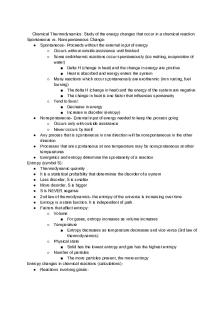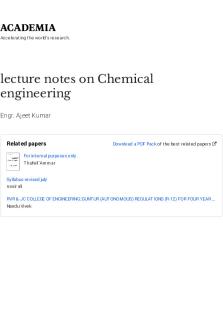9/22 Notes on LECTURE PDF

| Title | 9/22 Notes on LECTURE |
|---|---|
| Course | Music In Civilization |
| Institution | Baruch College CUNY |
| Pages | 5 |
| File Size | 404.2 KB |
| File Type | |
| Total Downloads | 83 |
| Total Views | 146 |
Summary
Professor Ted Gordon...
Description
Listen, Ch. 6.3, 6.4, Global Perspectives (p. 53–60) Listen to: - “Viderunt Omnes” plainchant (ca. 900–1100) - “Viderunt Omnes”, 2- and 4-part Organum by Leonin & Perotin (ca. 1100)
● We know about the earliest uses of European polyphony (two or more melodies combined played at the same time) from the church ● Organum: the earliest type of polyphony where a composer/singer/improvisor adds another melody to a traditional plainchant melody, which are sung at the same time with the same words Stages of the organum:
●
Perotin (probably) wrote the chant “Alleluia. Diffusa est gratia” for the Mass. It was dedicated to the Virgin Mary, like many other organa at the time, who was the patron saint of Notre Dame Cathedral. ○ The opening “Alleluia” section is the most important because it comes back twice before the chant is over ○ “The exclamation “Alleluia” often calls for especially long melismas, passages of pure, joyful vocalism” ○ (Refer to textbook for full description of organum)
● ●
After 1200: polyphonic music started moving away from church services. Motet: a new genre where composers took a part of a Gregorian chant and repeated it a
●
●
●
few times over in the bottom voice. On top of it they layered two more voices each with their words (love poems, commentaries of political developments, etc); it had two different sets of lyrics at the same time “Sumer Is Icumen In” - 4 voices carry the tune, while 2 more voices below them repeat “sing cuckoo” Ars Nova: “new art”, “new technique” ○ Motet continued as a new, important genre, while the organum of the Notre Dame composers was considered ars antigua (= “ancient art”) Polyphonic music in the 14th century grew very complex, as did architecture, painting, and poetry. ○ Isorhythm: Motets used this complex structural technique ○ Rhythmic patterns with a lot of long notes were repeated in “equal rhythm” (=isorhythm) but with different pitches each time
●
Guillaume de Machaut (c. 1300-1377) composed many motets using isorhythmic techniques that were secular polyphony. ○ Chansons: songs that did not reflect Gregorian chant at all ○ Machaut wrote the chanson “Dame, de qui toute ma joie vient” ■ 4 voices ■ Non Imitative polyphony ■ Top line was probably made for singing, but the other three could be made instrumental or vocal - we don’t know ■ Words are parceled out slowly, with long melismas on many syllables (similar to the style of organum and the most fancy genres of plainchant) ■ Form: a a’ b ■ Because the song is so long, a letter stands for a whole section instead of melodic phrase or two ■ Each section comes to a clear cadence (= stop) Global Perspectives: Sacred Chant ● Societies around the world have each created their own music. There are similarities between different society’s “musics”. Some come as a result of influence on one another, and some we believe that certain basic music functions and is just universal to all humans. ● One of the most fundamental roles of music is in the service of religion ● Islam: Reciting the Qur’an ○ Qur'anic recitation is distinguished from any type of secular music making ○ The sacred text is read aloud, not sung. It is monophonic and nonmetric and instrumental like Gregorian chant (Refer to textbook for the rest of page 60-61) In Class Notes Medieval Polyphony
(or, “what should we do about the fact that more than one person can sing at a time?”) Topics: ● Gregorian Chant (Plainchant) ● Polyphony in Church: Organum (plural: organa) ● Ars Antiqua vs. Ars Nova Why invent “Gregorian Chant”? Charlemagne’s Empire to 814 CE “How did music spread around the world at this time?” Charlemagne's basically invented Cultural Hegemony: the power of enforced culture to erase local, ethnic, and other differences “Gregorian” Chant ● Pope Gregory I, ca 600 CE ● Probably invented by Charlemagne (ca. 800 CE) ○ A made up story by Charlemagne to legitimize his power: He said a dove went into the window and sang these chants to Pope Gregory ● Standardized set of chants to be sung in all churches in Charlemagne’s empire (“Holy Roman Empire”) ● Plainchant: monophonic, written in pneumatic notation ● Example (from textbook): “In Paradisum” ● Another Example: “Viderunt Omnes” ● Gregorian chant is attributed to Pope Gregory but most likely was written by someone in Charlamagne’s empire Sacred Polyphony (Or: “How do we attract these kinds of people into the church?”) Jongleurs (ca. 990-1010 CE) (pictures in slideshow)
The Power/Danger of Music “How would people listen to music if they were scared of its power?” (pictures in slideshow)
Medieval Christian Cosmology of Music ● Musica Universalis ● Musica Mundana ○ Closest you could get to universal music with the human voice ● Musica Instrumentalis ○ Instrumental music - lowest form of music ○ Did not like having instrumental music in the church “Florence Manuscript” (ca. 1255), verso of opening folio ------>
Church Architecture ca. 900-ish (pictures in slideshow)
Organum: A small piece of plainchant (usually a well known one) that you extract a small melody from the bottom, and add a melisma on top. In the medieval mind, “threeness” was very important. Ars Antiqua (“ancient art”) VS. Ars Nova (“new art”) - Old school vs. new school music How could you describe the differences between these two pieces of music? Composer: Perotin Composer: Guillaume de Machaut Title: “Viderunt Omnes” Title: “Dame, de qui toute ma jolie vient” Genre: Organum Genre: Chanson (song) Date: ca. 1200? Date: ca. 1350? -
Perotin has differences between the melodic lines Ars Nova had a more complex counterpoint (relationship between melodic lines), while Ars Antiqua was more simple The Ars Antiqua is sung by 4 four males all of the same range, while the Ars Nova reaches different, bigger ranges of pitches The Ars Nova is nonimitative polyphony; very complex...
Similar Free PDFs

Lecture notes on Boosting
- 11 Pages

Lecture on feminism - Notes
- 6 Pages

Lecture Notes on Elements
- 3 Pages

Lecture notes on Fraud
- 8 Pages

Lecture Notes on The Descent
- 9 Pages

Notes on Lecture 8 - London
- 7 Pages

CPR - Lecture notes on CPR
- 2 Pages

9/22 Notes on LECTURE
- 5 Pages

Lecture Notes on Actuarial Mathematics
- 320 Pages

LECTURE NOTES ON COMPRESSOR(2019)
- 21 Pages
Popular Institutions
- Tinajero National High School - Annex
- Politeknik Caltex Riau
- Yokohama City University
- SGT University
- University of Al-Qadisiyah
- Divine Word College of Vigan
- Techniek College Rotterdam
- Universidade de Santiago
- Universiti Teknologi MARA Cawangan Johor Kampus Pasir Gudang
- Poltekkes Kemenkes Yogyakarta
- Baguio City National High School
- Colegio san marcos
- preparatoria uno
- Centro de Bachillerato Tecnológico Industrial y de Servicios No. 107
- Dalian Maritime University
- Quang Trung Secondary School
- Colegio Tecnológico en Informática
- Corporación Regional de Educación Superior
- Grupo CEDVA
- Dar Al Uloom University
- Centro de Estudios Preuniversitarios de la Universidad Nacional de Ingeniería
- 上智大学
- Aakash International School, Nuna Majara
- San Felipe Neri Catholic School
- Kang Chiao International School - New Taipei City
- Misamis Occidental National High School
- Institución Educativa Escuela Normal Juan Ladrilleros
- Kolehiyo ng Pantukan
- Batanes State College
- Instituto Continental
- Sekolah Menengah Kejuruan Kesehatan Kaltara (Tarakan)
- Colegio de La Inmaculada Concepcion - Cebu





